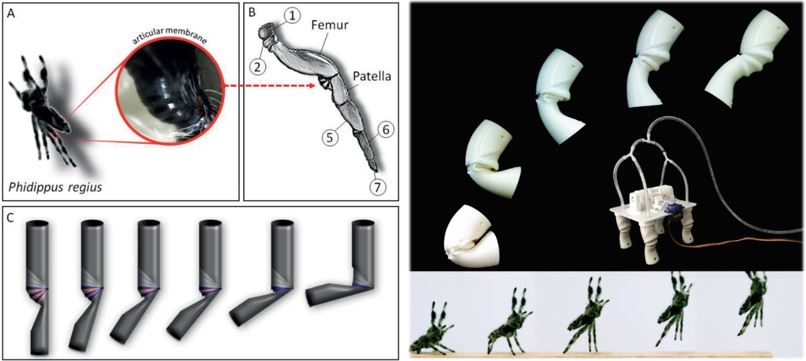
Jumping spiders (Phidippus regius) are known for their ability to traverse various terrains fast and have targeted jumps within the fraction of a second to catch flying preys. Different from humans and insects, spiders use muscles to flex their legs, and hydraulic actuation for extension. By pressurizing their inner body fluid, they can achieve fast leg extensions for running and jumping. Here, we investigate the working principle of the articular membrane covering the spider leg joint pit [ ]. This membrane is highly involved in the walking, grasping and jumping motions. We studied hardness and stiffness of the articular membrane using nanoindentation tests and developed preparation methods for scanning electron microscopy and histology to give detailed information about the inner and outer structure of the leg joint and its membrane. Inspired by the stroller umbrella-like folding mechanism of the articular membrane, a robust thermoplastic polyurethane-based rotary semi-fluidic actuator is demonstrated, which shows increased durability, achieves working angles over 120°, produces high torques which allows lifts over 100 times of its own weight and jumping abilities. The developed actuator can be used for future grasping tasks, safe human-robot interactions and multi-locomotion ground robot applications, and it could shed light into spider locomotion-related questions.
Next, we stdied fluid mechanics and rheology of the jumping spider body fluid [ ], which has not been reported before. Spiders use their inner body fluid ("blood" or hemolymph) to drive hydraulic extension of their legs. In hydraulic systems, performance is highly dependent on the working fluid, which needs to be chosen according to the required operating speed and pressure. Here, we provide new insights into the fluid mechanics of spider locomotion. We present the three-dimensional structure of one of the crucial joints in spider hydraulic actuation, elucidate the fluid flow inside the spider leg, and quantify the rheological properties of hemolymph under physiological conditions. We observe that hemolymph behaves as a shear-thinning non-Newtonian fluid.
